Luxury hospitality and sustainability are often considered counter-intuitive. However, projects like Suryagarh in Jaisalmer and Narendra Bhawan in Bikaner defy this dichotomy. The opulence and luxury of these projects comes with the use of indigenous crafts and wisdom to create transformative experiences. Initiatives of the MRS Group, led by Manvendra Singh Shekhawat – a visionary entrepreneur working towards community-driven sustainable development – and designed and executed by Ayush Kasliwal and Geetanjali Kasliwal, founders of AKFD Studio (Ayush Kasliwal Design Pvt. Ltd.) and AnanTaya (lifestyle and decor brand), the two projects are “biographies in space”, as described by Ayush Kasliwal. He also shares his vision of crafts as “an element of care”, and as something that is “not superimposed, but is our second nature and a part of our language.” Geetanjali Kasliwal describes their approach to luxury hospitality as rooted in “essentiality” and focused on “creating a deeper experience in a smaller space.
She shares that Ayush’s deep engagement and rich exposure to crafts led them to initially teach crafts and culture to kids in their neighbourhood and city for over two years, in collaboration with the Jaipur Virasat Foundation. Other projects include the MaahiRoj Festival, which is a first-of-its-kind sustainability festival and an effort to understand conscious living. These projects became the means to understand crafts, possibilities, and the way craft ecosystems work. She further adds that bringing together the intelligence of common people is one of the studio’s key strengths. This also resonates in the passions of Manvendra Singh Shekhawat, who believes in the value of incorporating the wisdom of indigenous communities to shape living environments.
Ayush Kasliwal on crafts as an element of care; Geetanjali Kasliwal on creating a deep experience—essential luxury. © ArchitectureLive!
Unique Creative Practices
The success of the two projects also lies in the unique practices of both the designers and the client. For AKFD, the primary verticals are Retail, Projects, Exports, and Consultancy. The innovativeness of the studio’s business model comes from its ability to switch intelligently between different verticals depending on market conditions. Ability to export furniture across the globe right from the beginning, allowed them to go from making one bespoke product to a thousand pairs, which gave them another strength. Geetanjali Kasliwal, whose entrepreneurial spirit is influenced by her architectural background, shares that this flexibility has allowed the studio to build a successful business by solving client problems uniquely, while starting at a time when there were no markets or connections to ecosystems that exist today. The studio’s first-of-its-kind business model goes hand-in-hand with design being the key differentiator.


Manvendra Singh Shekhawat, owner of the MRS Group, a luxury hospitality business, also runs Dhun Jaipur, a 500-acre neighbourhood that includes working, learning, and recreational spaces aimed at integrating the collective wisdom of indigenous communities into urban design. He shares his fascination with distant lands, the extraordinary stories they hold, and their general diversity. He views his work with hotels and urban spaces as aligned in values—both focus on creating transformational experiences by leveraging indigenous community wisdom. This drives his commitment to sustainability. According to him, hotels emerge as platforms for cultural incubation.
This approach aligned well with Ayush Kasliwal’s vision to empower 1 million craftspeople through these projects and provide them with tools of self-sufficiency. The intention is to elevate the conversation on crafts beyond the standard conversation on livelihoods, offering individuals the chance to be part of something bigger than themselves. Such opportunities help instil respect, a sense of ownership, and identity. In this context, craft is seen as a series of processes rather than products, and as an integral part of everyday life. Consequently, in both Suryagarh and Narendra Bhawan, each piece is original and individual, with none of the artwork being reproduced.
Geetanjali Kasliwal on AKFD’s practice; Manvendra Singh Shekhawat on his practice. © ArchitectureLive!
Thar Apartments at Suryagarh, Jaisalmer
One example of how the idea of craft was pushed at Suryagarh in Jaisalmer is through the reproduction of a dhurrie pattern that had fallen out of production, recreated solely from a photograph taken in the 1970s. From a design perspective, Suryagarh is conceptualised as a “city on the roof”. Given the city’s high footfall of traders, the intention was to create a space that has an ease of coming home. Ayush further shares, “If you look at homes, which have been packed up and opened up once in a while. They’re not filled with stuff. They’re spare, they are easy, the kind of thing that there’s a space that envelopes you when you’re there.” The hotel, built in sandstone, is set against the cerulean blue sky, with rooms designed to frame the sky through the courtyard. This blue sky highlights the yellow sandstone, becoming the distinctive factor.



Narendra Bhawan, Bikaner
Narendra Bhawan of Bikaner has a different sensibility and emerges as a biography of its owner, Narendra Singh ji, the last reigning Maharaja of the city. Made in a challenging location within the urban sprawl of the city, it is positioned as an inward-looking oasis. Initially intended as a hospital and later a business hotel, it ultimately became an 82-room hotel to honour the story and distinct personality of its owner. As Manvendra recalls, the brief was to design the house of “a mad uncle who everybody loves”. Through stories from friends and family, as well as a set of letters, Manvendra discovered that Narendra Singh ji was an eccentric man with eclectic tastes. He was kind and benevolent, who had a special love for his pets, which included over 500 cows and 86 dogs and doves. A particular photograph of Narendra Singh ji, sitting inside the red room on a red bed with a red fridge in the background, captures this distinctness and became the design inspiration for the hotel. One of the key people who embodied the spirit of Narendra Singh ji and pushed the refinement of the story is the late Karan Singh, former President of the MRS Group and an internationally-qualified hotelier yet deeply rooted in the Indian context.
Spatially, the Maharaja’s house is the inner building, which has remained intact with the new building made around it, abutting it. This allowed the old and new buildings to connect at the ground floor and first floor, with the roof of the old building becoming a courtyard for the upper floors. The distinct personality of the owner shines through spaces like the Regimental Rooms, inspired by the Maharaja’s army training. One artwork behind the bed in this room is an imaginary embroidered coat of arms made by an artisan in Banaras. This piece exemplifies how the idea of craft was pushed by giving the artisan an opportunity to create first-of-a-kind work, which he took great pride in, keeping the artwork and remaking it later. The building’s extensive terrazzo floors, made in Bikaner, are another example of how craft was pushed.
Another distinct space in the hotel is the Deep Red Office, inspired by the aforementioned photograph of the Maharaja. This room became aspirational, allowing guests to imagine themselves as the Maharaja. Geetanjali further adds, “Can you imagine an office which is completely red, is cultural yet has a clean design. A clean lined, modern, leather upholstered teak sofa sits in complete contrast in a cultural setting. This layered juxtaposition is seamlessly done throughout the property and creates magic. Guests can imagine themselves as a modern Maharaja being welcomed in his home and discover layered experiences.” The spatial experience is further enriched by how the services blend into the overall narrative and design. Ayush emphasises this by sharing how “a simple greeting, Jai Jai, itself makes the space distinctive.”
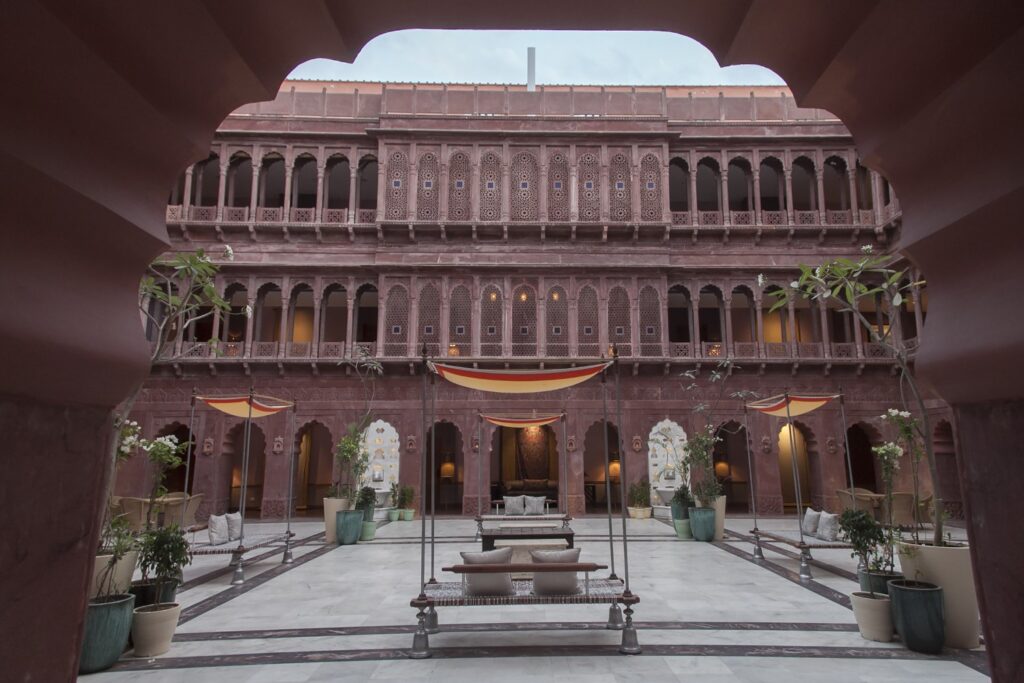
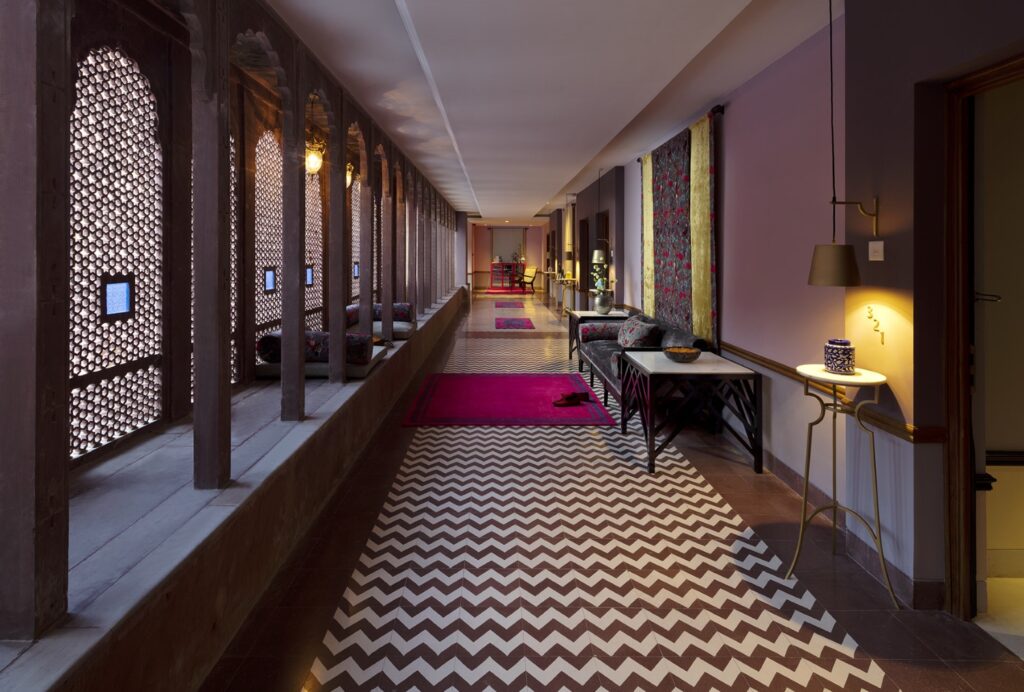
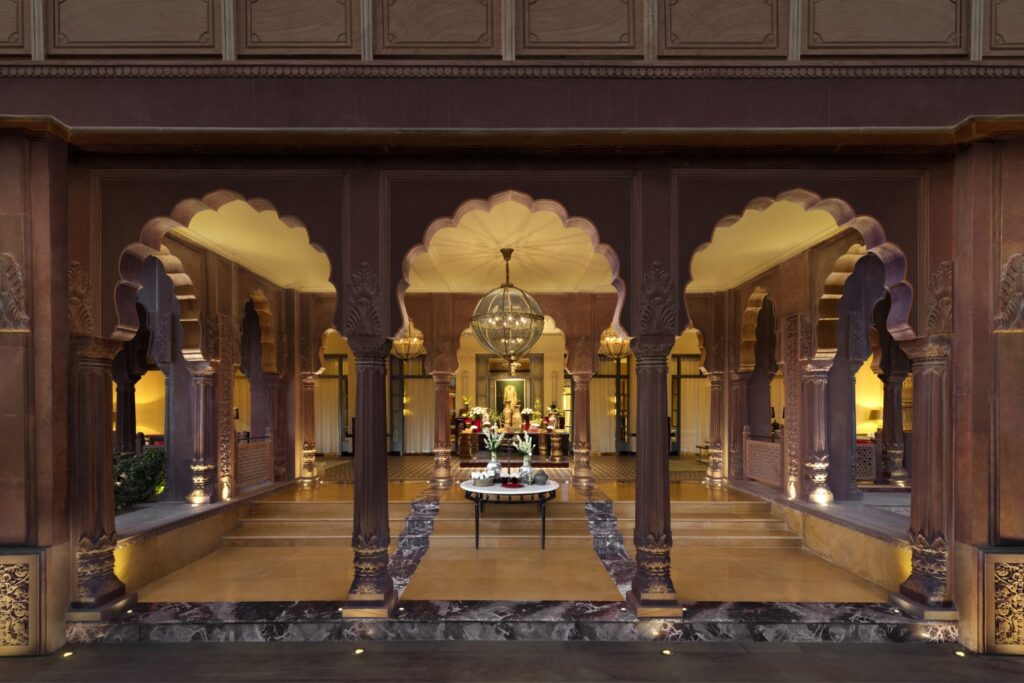
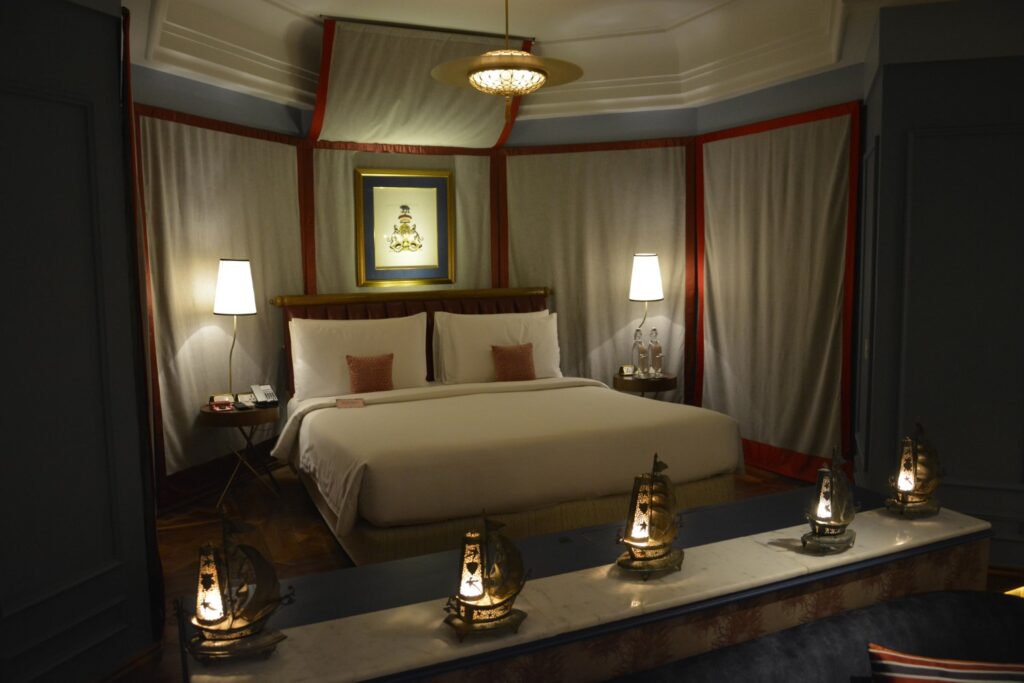
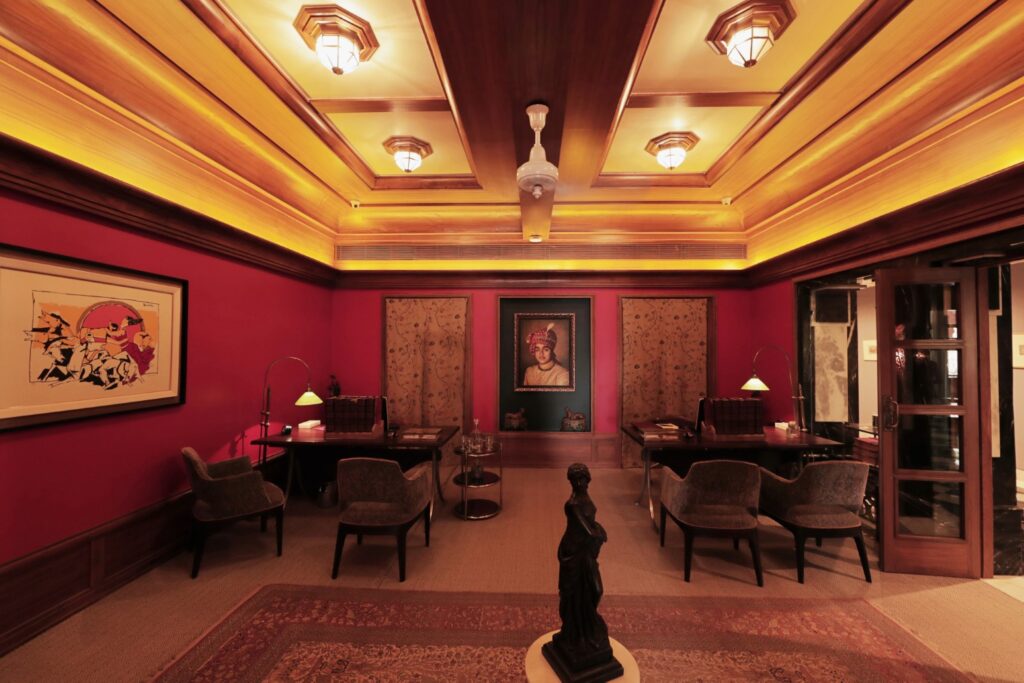
Redefining Experiential Luxury
Both the projects have received international recognition and are much loved by visitors, reminding them of their own homes. Remarkably, the project achieved breakeven in its first year despite challenges such as limited connectivity to Bikaner, with only one operational flight of Alliance Air, which affects the hotel’s pricing potential. Ayush and Geetanjali Kasliwal share that one of the best compliments the hotel has received came from their daughter, who said “Mujhe Bikaner vaale ghar jaana hai” (“I want to go to the house in Bikaner”). This sense of home as a constantly evolving space is what they hoped to create. For instance, bright red cabinets with little vignettes of dolls line the corridors, which Ayush loves to arrange and rearrange on his every visit. He also shares, “Very often, we fall into the trap of making a space pretty or authentic to a certain time or period, but our homes are not like that. Our homes live across multiple times and this is the great realisation we had.”
Pushing boundaries through creativity and a shared purpose is crucial to the design process. Manvendra sees his role as a facilitator, bringing together passionate minds to collide, debate fiercely, and work beyond their individual biases. His aim is to inspire excitement about the end goal and allow something extraordinary that transcends the physical to emerge. Central to this process are questions like what story to tell about a region and how to create conditions that allow human potential to reach its fullest. He goes on to say that one is “bound to notice craft, story, and lineage in these spaces.”
Ayush Kasliwal and Manvendra Singh on craft. © ArchitectureLive!
Hotels, as spaces frequented by influential people, present significant opportunities for promoting indigenous local crafts. Projects like Narendra Bhawan and Suryagarh demonstrate how luxury hospitality can embrace indigenous community wisdom without compromising on opulence. They redefine luxury by emphasising experiential quality and cultural value, and creating deeper experiences within smaller spaces. These hotels shift the paradigm from aspirational to experiential and transformational. In contemporary times, while the craftsperson has not disappeared, the patron has, and such projects provide opportunities for patronage.
By valuing indigenous crafts and empowering local communities, they have the potential to usher in a new era in hospitality where luxury encompasses essentiality, homeliness, cultural richness and ecological responsibility, and where craft is not a product, but an element of care.






